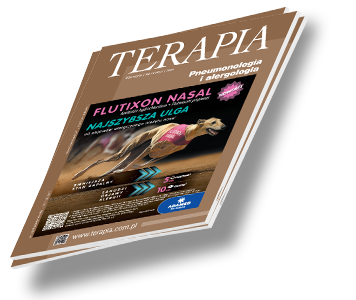Alergologia Terapia 2018, 4 ( 363 ) : 37 - 41
Terapia trójlekowa (wGKS/LABA/LAMA) z jednego inhalatora w przewlekłej obturacyjnej chorobie płuc (POChP)
Triple therapy (ICS/LABA/LAMA) from one inhaler in the management of chronic obstructive pulmonary disease (COPD)
Pod pojęciem terapii trójlekowej, zwanej również terapią potrójną, rozumiemy połączenie glikokortykosteroidu wziewnego (wGKS), długo działającego agonisty receptora b (long-acting beta-agonist, LABA) i długo działającego leku antycholinergicznego (long-acting muscarinic antagonist, LAMA) w jednym inhalatorze. Zgodnie z zaleceniami GOLD 2018 (1), terapia trójlekowa stanowi podstawę leczenia przewlekłej obturacyjnej choroby płuc (POChP) u pacjentów z grupy D, którzy pomimo zastosowania kombinacji dwóch leków: LAMA/LABA lub wGKS/LABA, w dalszym ciągu mają uporczywe objawy lub dalsze częste zaostrzenia.

Zaloguj się i przeczytaj bezpłatnie całą treść artykułu.
Nie masz jeszcze konta dostępowego?
Zarejestruj się bezpłatnie, a otrzymasz:
* dostęp do wszystkich doniesień oraz pełnych tekstów artykułów naukowych w naszej Czytelni,
* prawo do bezpłatnego otrzymywania newslettera "Aktualności TERAPIA" z przeglądem interesujących i przydatnych wiadomości ze świata medycyny oraz systemu ochrony zdrowia w Polsce i na świecie,
* możliwość komentowania bieżących wydarzeń oraz udziału w ciekawych quizach i konkursach.
Zapraszamy serdecznie, dołącz do naszej społeczności.



Dodaj komentarz